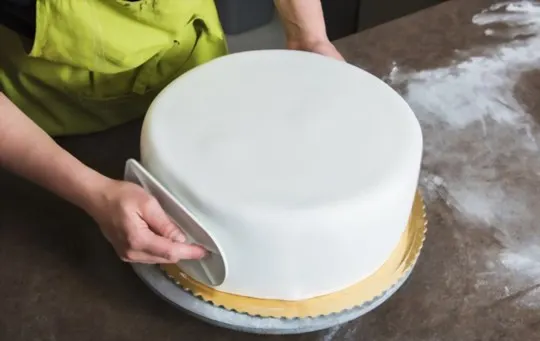Have you ever been presented with a plate of white cake, not sure how to even begin to describe the flavor?
Well, luckily for you, that’s why we’re here!
We’ve got an in-depth guide on exactly what white cake tastes like.
From variations in texture and taste, to which ingredients give it its signature flavour—we’ve broken down all there is to know about this timeless dessert staple.
With this comprehensive breakdown of all things white cake related, no matter your palate or cravings you’ll be able to find something delicious within our guide.
What is White Cake?

White Cake is a popular type of cake that is primarily composed of flour, sugar, eggs, butter, and vanilla extract.
It is called “white” because it lacks any other added colors or flavors.
This type of cake is known for its light and fluffy texture and its versatile nature that allows it to be used as a base for various types of cakes.
White Cake is a classic cake recipe that has been enjoyed by many for generations.
It is typically made with basic ingredients that can easily be found in most kitchens.
The process of making white cake involves combining the dry ingredients with the wet ingredients and mixing them until smooth.
The batter is then poured into baking pans and baked until golden brown.
In terms of appearance, white cake has a light color and a smooth texture.
Its fluffy consistency makes it ideal for layering and decorating with frosting or other toppings.
The simplicity of this type of cake makes it easy to customize to suit different preferences.
White Cake can be used as a base for various types of cakes such as wedding cakes or layered cakes.
It can also be served on its own with a dusting of powdered sugar or a dollop of whipped cream on top.
What Does White Cake Taste Like?

White cake tastes sweet, light, and fluffy.
The flavor is delicate, with hints of vanilla or almond.
The texture is soft and moist due to the use of butter or oil in the recipe.
White cake is popular for its versatility in flavors and ability to pair well with various frostings and fillings.
To enhance the taste of white cake, bakers often add ingredients such as sour cream, buttermilk, or lemon zest.
These additions add a tangy flavor that complements the sweetness of the cake.
The taste of white cake also depends on the type of flour used in the recipe.
Cake flour creates a finer crumb and a lighter texture, while all-purpose flour results in a slightly denser texture.
Another factor that affects the flavor of white cake is the type of sugar used.
Granulated sugar adds a neutral sweetness, while brown sugar adds a molasses undertone to the flavor.
Ingredients That Affect the Flavor of White Cake
White cake is a popular dessert item, often found at celebrations such as weddings and birthdays.
While the taste of white cake is typically sweet, there are various ingredients that can affect its flavor.
Some of these key ingredients and their impact on the overall taste of white cake are outlined below.
Butter has a particularly strong influence on both the taste and texture of white cake.
It adds richness and depth to the overall flavor profile, resulting in a creamier taste.
In addition, using egg whites can help to create a lighter texture in the cake which can also enhance its overall sweetness.
Milk is another common ingredient that affects the flavor of white cake.
It offers a subtle sweetness while also adding moisture to the cake, which can greatly impact its final texture.
Lastly, salt helps to balance out any excess sweetness while also enhancing other flavors present in the cake.
How to Enhance the Flavor of White Cake?

Enhancing the flavor of a white cake can bring an additional sweetness and richness to it.
So let’s dive into some simple steps that can be followed to enhance the flavor of a white cake.
- Include flavor extracts – Adding vanilla, almond and coconut extracts can add subtle flavour and aroma to your white cake.
- Add citrus zest – Zesting lemon or orange peel and adding it into the batter will give a tangy taste, which cuts down the sugariness of the cake.
- Use salted butter – Salted butter adds a caramelized flavour along with intense notes of nutty richness to your white cake.
- Replace whole milk with buttermilk – Buttermilk provides acidity that gives a tangy taste while also lending tenderness and moistness to the crumb texture.
- Incorporate sour cream in batter – Sour cream allows for a denser texture along with providing moisture which keeps the cake from drying out too quickly. It also gives a pleasant tartness, contributing just as much flavour as it does structure when added in certain portions.
- Experiment with spices – Spices like cinnamon, nutmeg, ginger or cardamom when added in small quantities keep things interesting by giving rich depth over time as you eat various bites across different slices of white cake.
Adding any one or more combination of such ingredients mentioned above is going to make your white cake flavorful than ever before.
White cakes have been known to come off as quite plain tasting without any distinguishable flavors.
That may seem challenging if you’re trying to bake this classic dessert.
However, there are solutions available which can make your white cake all sorts of delicious.
Now that we’ve got some insights on how we can enhance its flavors, let’s get ready to roll up our sleeves and do some baking.
Incorporating flavors to your white cake batter can be quite simple, with no significant studies required.
All you need is an accumulation of right ingredients and tiny measurements for tasting the best success outcome.
1 – Add Fruit or Flavorings
Adding fruit or flavorings is a great way to enhance the taste of white cake.
First of all, you can add fresh or frozen fruits to your cake batter.
You can also add extracts or essences, such as vanilla extract or almond extract, to give your cake a distinct flavor.
Additionally, you can experiment with different types of spices and herbs that complement the flavors in your cake.
When adding fruit to your white cake batter, there are a few things to keep in mind.
- Make sure that the fruit is washed and dried before adding it to the batter.
- You should cut up larger fruits into smaller pieces so that they mix more evenly throughout the batter. Lastly, if you are using frozen fruit, make sure it is thawed before use.
If you want to add extracts or essences to your white cake, start by adding one tablespoon at a time and taste-testing as you go.
This will help you achieve a more balanced and nuanced flavor profile.
Experimenting with spices and herbs can also bring new dimensions of flavor to your white cake.
Some popular options include cinnamon, nutmeg, cardamom, and ginger.
However, be careful not to overpower the other flavors in your cake – a little goes a long way.
2 – Use High-Quality Ingredients
White cake is often associated with special occasions such as weddings and birthdays.
To create a perfect white cake, it is important to use high-quality ingredients.
This means using fresh ingredients and avoiding artificial flavorings or colorings.
Using high-quality ingredients can greatly impact the taste and texture of the cake.
For example, using fresh and high-quality butter can make the cake much more flavorful than using low-quality margarine or shortening.
The same goes for other ingredients such as flour, sugar, eggs, and milk.
In addition to improving the taste of the cake, using high-quality ingredients can also improve its overall texture.
High-quality flour will help create a lighter and fluffier cake while fresh eggs will add moisture that will keep the cake from drying out.
It’s important to note that not all expensive ingredients are high-quality.
It’s important to do your research and find brands that are known for their quality rather than just their price tag.
By using high-quality ingredients in your white cake recipe, you can ensure a delicious and moist cake with a delicate crumb that melts in your mouth.
3 – Experiment with Frostings and Fillings
In order to add a personal touch to your white cake.
Vanilla buttercream is a classic choice for white cake, but you can also consider other options such as cream cheese frosting or chocolate ganache.
You can even experiment with different flavors by adding extracts like almond or peppermint to your frosting recipe.
Another way to add some diversity to your white cake is through fillings.
Traditional options include fruit preserves and pastry cream, but you can also try out unique fillings like lemon curd or caramel sauce.
Just make sure that the filling consistency complements the texture of your cake.
When experimenting with frostings and fillings, it’s important to keep in mind the overall balance of flavors.
A too-sweet frosting can overpower the delicate flavor of white cake, while a tart filling may not be the right fit.
Conclusion
If you’ve made it this far, congratulations.
You now have a good understanding of white cake and some ideas for how to jazz it up with different frosting and filling combinations.
But as we come to the end of this article, there are a few final thoughts to leave you with.
It’s worth reiterating that white cake is a classic for a reason.
Its light, fluffy texture and delicate flavor make it a crowd-pleaser at any party or gathering.
Whether you’re hosting a birthday bash or a bridal shower, white cake is always a safe bet.
We hope this article has given you some inspiration for your next baking project.
White cake may seem simple at first glance, but there’s plenty of room for experimentation and customization.
So grab your apron and get baking – the world of white cakes is waiting for you.

What Does White Cake Taste Like? A Comprehensive Guide
Ingredients
- White cake
- Ingredients from your selected recipes
Instructions
- Select ingredients that work well together.
- Use a recipe or method that will enhance their natural taste.
- Taste and adjust the recipe as needed to achieve the desired flavor.

Carrie is a food writer and editor with more than 15 years of experience. She has worked for some of the biggest names in the food industry, including Bon Appétit, Food & Wine, and Martha Stewart Living.
As the Editor in Chief of IntroChicago.com, Carrie oversees all of the content on the site. She also manages the team of contributing writers and editors, who help to create delicious recipes, helpful tips, and informative articles that you’ll find on the site.
A native of the Chicago area, Carrie is passionate about all things food. She loves trying new restaurants and experimenting with new recipes in her kitchen. She’s also a graduate of the Culinary Institute of America, so she knows a thing or two about food!
